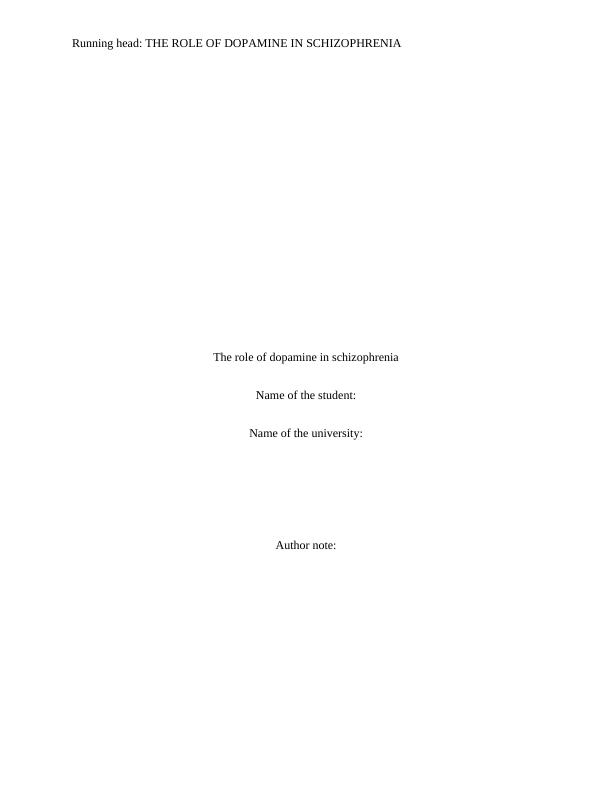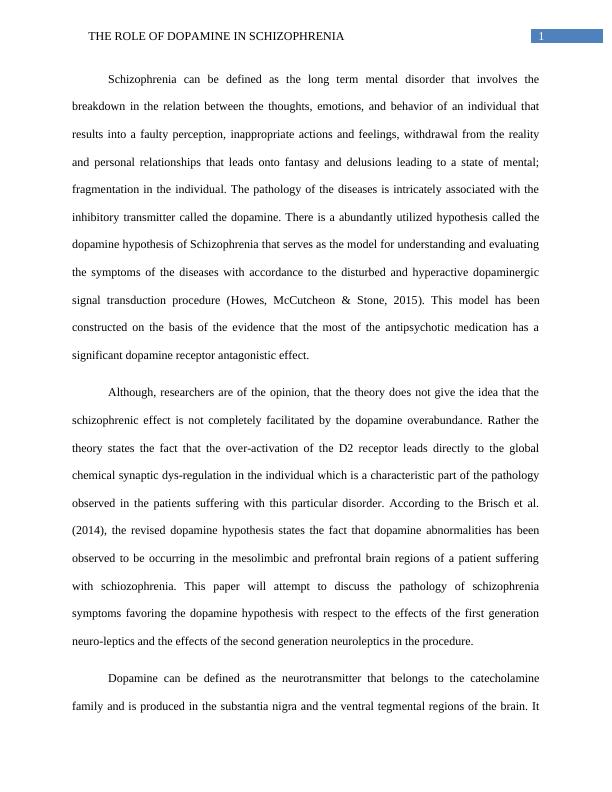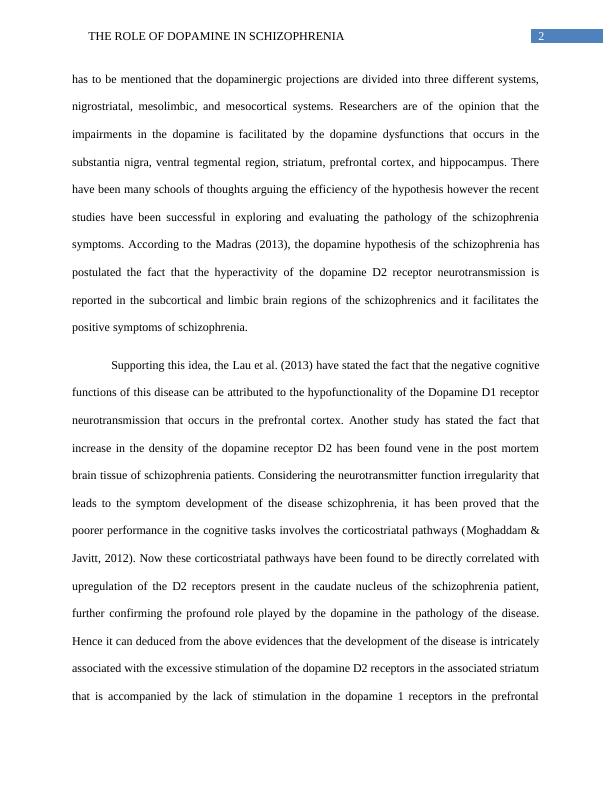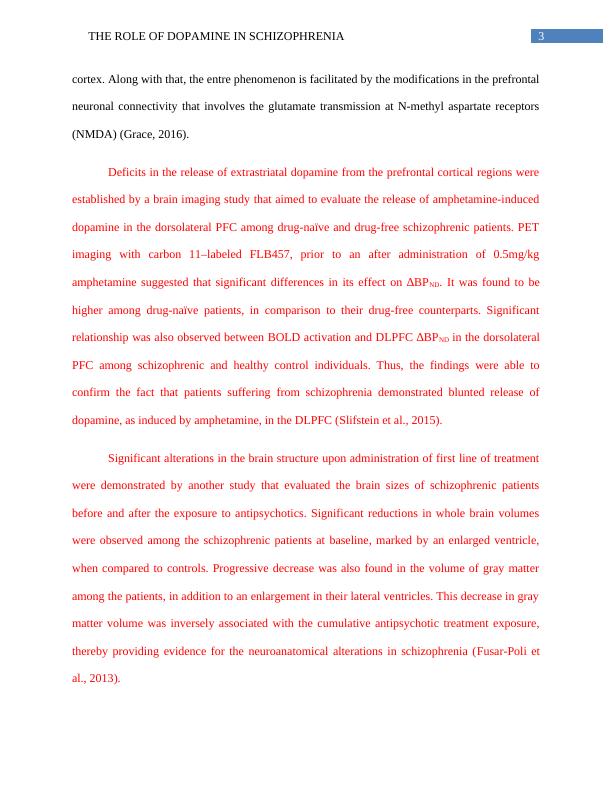The Role of Dopamine in Schizophrenia
Added on 2023-06-11
11 Pages2827 Words457 Views
Running head: THE ROLE OF DOPAMINE IN SCHIZOPHRENIA
The role of dopamine in schizophrenia
Name of the student:
Name of the university:
Author note:
The role of dopamine in schizophrenia
Name of the student:
Name of the university:
Author note:

1THE ROLE OF DOPAMINE IN SCHIZOPHRENIA
Schizophrenia can be defined as the long term mental disorder that involves the
breakdown in the relation between the thoughts, emotions, and behavior of an individual that
results into a faulty perception, inappropriate actions and feelings, withdrawal from the reality
and personal relationships that leads onto fantasy and delusions leading to a state of mental;
fragmentation in the individual. The pathology of the diseases is intricately associated with the
inhibitory transmitter called the dopamine. There is a abundantly utilized hypothesis called the
dopamine hypothesis of Schizophrenia that serves as the model for understanding and evaluating
the symptoms of the diseases with accordance to the disturbed and hyperactive dopaminergic
signal transduction procedure (Howes, McCutcheon & Stone, 2015). This model has been
constructed on the basis of the evidence that the most of the antipsychotic medication has a
significant dopamine receptor antagonistic effect.
Although, researchers are of the opinion, that the theory does not give the idea that the
schizophrenic effect is not completely facilitated by the dopamine overabundance. Rather the
theory states the fact that the over-activation of the D2 receptor leads directly to the global
chemical synaptic dys-regulation in the individual which is a characteristic part of the pathology
observed in the patients suffering with this particular disorder. According to the Brisch et al.
(2014), the revised dopamine hypothesis states the fact that dopamine abnormalities has been
observed to be occurring in the mesolimbic and prefrontal brain regions of a patient suffering
with schiozophrenia. This paper will attempt to discuss the pathology of schizophrenia
symptoms favoring the dopamine hypothesis with respect to the effects of the first generation
neuro-leptics and the effects of the second generation neuroleptics in the procedure.
Dopamine can be defined as the neurotransmitter that belongs to the catecholamine
family and is produced in the substantia nigra and the ventral tegmental regions of the brain. It
Schizophrenia can be defined as the long term mental disorder that involves the
breakdown in the relation between the thoughts, emotions, and behavior of an individual that
results into a faulty perception, inappropriate actions and feelings, withdrawal from the reality
and personal relationships that leads onto fantasy and delusions leading to a state of mental;
fragmentation in the individual. The pathology of the diseases is intricately associated with the
inhibitory transmitter called the dopamine. There is a abundantly utilized hypothesis called the
dopamine hypothesis of Schizophrenia that serves as the model for understanding and evaluating
the symptoms of the diseases with accordance to the disturbed and hyperactive dopaminergic
signal transduction procedure (Howes, McCutcheon & Stone, 2015). This model has been
constructed on the basis of the evidence that the most of the antipsychotic medication has a
significant dopamine receptor antagonistic effect.
Although, researchers are of the opinion, that the theory does not give the idea that the
schizophrenic effect is not completely facilitated by the dopamine overabundance. Rather the
theory states the fact that the over-activation of the D2 receptor leads directly to the global
chemical synaptic dys-regulation in the individual which is a characteristic part of the pathology
observed in the patients suffering with this particular disorder. According to the Brisch et al.
(2014), the revised dopamine hypothesis states the fact that dopamine abnormalities has been
observed to be occurring in the mesolimbic and prefrontal brain regions of a patient suffering
with schiozophrenia. This paper will attempt to discuss the pathology of schizophrenia
symptoms favoring the dopamine hypothesis with respect to the effects of the first generation
neuro-leptics and the effects of the second generation neuroleptics in the procedure.
Dopamine can be defined as the neurotransmitter that belongs to the catecholamine
family and is produced in the substantia nigra and the ventral tegmental regions of the brain. It

2THE ROLE OF DOPAMINE IN SCHIZOPHRENIA
has to be mentioned that the dopaminergic projections are divided into three different systems,
nigrostriatal, mesolimbic, and mesocortical systems. Researchers are of the opinion that the
impairments in the dopamine is facilitated by the dopamine dysfunctions that occurs in the
substantia nigra, ventral tegmental region, striatum, prefrontal cortex, and hippocampus. There
have been many schools of thoughts arguing the efficiency of the hypothesis however the recent
studies have been successful in exploring and evaluating the pathology of the schizophrenia
symptoms. According to the Madras (2013), the dopamine hypothesis of the schizophrenia has
postulated the fact that the hyperactivity of the dopamine D2 receptor neurotransmission is
reported in the subcortical and limbic brain regions of the schizophrenics and it facilitates the
positive symptoms of schizophrenia.
Supporting this idea, the Lau et al. (2013) have stated the fact that the negative cognitive
functions of this disease can be attributed to the hypofunctionality of the Dopamine D1 receptor
neurotransmission that occurs in the prefrontal cortex. Another study has stated the fact that
increase in the density of the dopamine receptor D2 has been found vene in the post mortem
brain tissue of schizophrenia patients. Considering the neurotransmitter function irregularity that
leads to the symptom development of the disease schizophrenia, it has been proved that the
poorer performance in the cognitive tasks involves the corticostriatal pathways (Moghaddam &
Javitt, 2012). Now these corticostriatal pathways have been found to be directly correlated with
upregulation of the D2 receptors present in the caudate nucleus of the schizophrenia patient,
further confirming the profound role played by the dopamine in the pathology of the disease.
Hence it can deduced from the above evidences that the development of the disease is intricately
associated with the excessive stimulation of the dopamine D2 receptors in the associated striatum
that is accompanied by the lack of stimulation in the dopamine 1 receptors in the prefrontal
has to be mentioned that the dopaminergic projections are divided into three different systems,
nigrostriatal, mesolimbic, and mesocortical systems. Researchers are of the opinion that the
impairments in the dopamine is facilitated by the dopamine dysfunctions that occurs in the
substantia nigra, ventral tegmental region, striatum, prefrontal cortex, and hippocampus. There
have been many schools of thoughts arguing the efficiency of the hypothesis however the recent
studies have been successful in exploring and evaluating the pathology of the schizophrenia
symptoms. According to the Madras (2013), the dopamine hypothesis of the schizophrenia has
postulated the fact that the hyperactivity of the dopamine D2 receptor neurotransmission is
reported in the subcortical and limbic brain regions of the schizophrenics and it facilitates the
positive symptoms of schizophrenia.
Supporting this idea, the Lau et al. (2013) have stated the fact that the negative cognitive
functions of this disease can be attributed to the hypofunctionality of the Dopamine D1 receptor
neurotransmission that occurs in the prefrontal cortex. Another study has stated the fact that
increase in the density of the dopamine receptor D2 has been found vene in the post mortem
brain tissue of schizophrenia patients. Considering the neurotransmitter function irregularity that
leads to the symptom development of the disease schizophrenia, it has been proved that the
poorer performance in the cognitive tasks involves the corticostriatal pathways (Moghaddam &
Javitt, 2012). Now these corticostriatal pathways have been found to be directly correlated with
upregulation of the D2 receptors present in the caudate nucleus of the schizophrenia patient,
further confirming the profound role played by the dopamine in the pathology of the disease.
Hence it can deduced from the above evidences that the development of the disease is intricately
associated with the excessive stimulation of the dopamine D2 receptors in the associated striatum
that is accompanied by the lack of stimulation in the dopamine 1 receptors in the prefrontal

3THE ROLE OF DOPAMINE IN SCHIZOPHRENIA
cortex. Along with that, the entre phenomenon is facilitated by the modifications in the prefrontal
neuronal connectivity that involves the glutamate transmission at N-methyl aspartate receptors
(NMDA) (Grace, 2016).
Deficits in the release of extrastriatal dopamine from the prefrontal cortical regions were
established by a brain imaging study that aimed to evaluate the release of amphetamine-induced
dopamine in the dorsolateral PFC among drug-naïve and drug-free schizophrenic patients. PET
imaging with carbon 11–labeled FLB457, prior to an after administration of 0.5mg/kg
amphetamine suggested that significant differences in its effect on ∆BPND. It was found to be
higher among drug-naïve patients, in comparison to their drug-free counterparts. Significant
relationship was also observed between BOLD activation and DLPFC ∆BPND in the dorsolateral
PFC among schizophrenic and healthy control individuals. Thus, the findings were able to
confirm the fact that patients suffering from schizophrenia demonstrated blunted release of
dopamine, as induced by amphetamine, in the DLPFC (Slifstein et al., 2015).
Significant alterations in the brain structure upon administration of first line of treatment
were demonstrated by another study that evaluated the brain sizes of schizophrenic patients
before and after the exposure to antipsychotics. Significant reductions in whole brain volumes
were observed among the schizophrenic patients at baseline, marked by an enlarged ventricle,
when compared to controls. Progressive decrease was also found in the volume of gray matter
among the patients, in addition to an enlargement in their lateral ventricles. This decrease in gray
matter volume was inversely associated with the cumulative antipsychotic treatment exposure,
thereby providing evidence for the neuroanatomical alterations in schizophrenia (Fusar-Poli et
al., 2013).
cortex. Along with that, the entre phenomenon is facilitated by the modifications in the prefrontal
neuronal connectivity that involves the glutamate transmission at N-methyl aspartate receptors
(NMDA) (Grace, 2016).
Deficits in the release of extrastriatal dopamine from the prefrontal cortical regions were
established by a brain imaging study that aimed to evaluate the release of amphetamine-induced
dopamine in the dorsolateral PFC among drug-naïve and drug-free schizophrenic patients. PET
imaging with carbon 11–labeled FLB457, prior to an after administration of 0.5mg/kg
amphetamine suggested that significant differences in its effect on ∆BPND. It was found to be
higher among drug-naïve patients, in comparison to their drug-free counterparts. Significant
relationship was also observed between BOLD activation and DLPFC ∆BPND in the dorsolateral
PFC among schizophrenic and healthy control individuals. Thus, the findings were able to
confirm the fact that patients suffering from schizophrenia demonstrated blunted release of
dopamine, as induced by amphetamine, in the DLPFC (Slifstein et al., 2015).
Significant alterations in the brain structure upon administration of first line of treatment
were demonstrated by another study that evaluated the brain sizes of schizophrenic patients
before and after the exposure to antipsychotics. Significant reductions in whole brain volumes
were observed among the schizophrenic patients at baseline, marked by an enlarged ventricle,
when compared to controls. Progressive decrease was also found in the volume of gray matter
among the patients, in addition to an enlargement in their lateral ventricles. This decrease in gray
matter volume was inversely associated with the cumulative antipsychotic treatment exposure,
thereby providing evidence for the neuroanatomical alterations in schizophrenia (Fusar-Poli et
al., 2013).

End of preview
Want to access all the pages? Upload your documents or become a member.